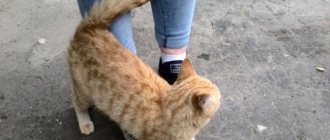Some people may not equate a cat with a "voice", perhaps because their language is different from a human's. Cats' communications are varied and specific, and their voice is a very important aspect. They use it in different ways to express a full range of emotions and feelings. When communicating with people, meowing is an important communication tool, especially when the cat needs something. How much a cat will meow depends on individual factors, but if a cat cannot meow at all, there is a reason for it.
In the article we will talk about why “the cat’s voice has disappeared,” we will look at the reasons why a cat’s meow becomes hoarse or disappears completely. We also see what we need to do with them, showing different treatment options for them.
Why doesn't the cat meow?
When a cat loses its voice, becomes squeaky, or all you hear is a squeak, it's understandable that we might think something is wrong. The main reasons why a cat loses its voice include:
- Laryngitis
- Other problems with the larynx
- Upper respiratory tract infection
- Vocal cord polyps
- Strain
- Stress
You may already know how important a role meowing plays in your relationship with your cat. By paying attention to you, cats do not necessarily understand the literal meaning of your words. Although it has been shown that cats can understand their own name. In most cases, they listen to the pitch, volume and intonation of these words. Likewise, when a cat speaks to us with its voice, we need to look at the overall context of the situation to understand what they want to say.
© shutterstock
Understanding what a cat means is easier said than done. A recent study found that whether you live with a cat is not a good indicator of your ability to understand what they want. Perhaps unsurprisingly, veterinarians had the best understanding of cat facial expressions. In addition to professional qualifications, being female and/or young allows a better understanding of whether a cat is happy or unhappy.
The above study only used images of a cat's face, highlighting the importance of listening to a cat's meow. Although there are many variations in a cat's meow, it is also important to know that a cat has many vocalizations. They may purr, chirp, grunt, meow, or make other sounds. When a cat loses their voice, it affects their communication with us, potential mates, threats, or anyone else they may encounter. This puts their well-being at risk, so it is important to diagnose the cause of voice loss and begin treatment.
What to do if you lose consciousness
The body is firmly fixed, the neck should be straight. The cat's oral cavity is closed, cleared of saliva, mucus and other secretions. We take a deep breath and release air into the pet’s nose through a cupped palm.
If the heartbeat has stopped, you should clasp your chest with your thumb on one side and your other fingers on the other. Make at least 5 presses, release and blow air into your nose in the manner described above.
Preventative measures include regular visits to the veterinarian. At least once every 3-4 months . Get vaccinated against worms and other parasites, especially in the summer. Clean your apartment thoroughly and ventilate the room.
ATTENTION! Ultimately, a timely response to the first wheezing or shortness of breath will help to more accurately determine the diagnosis and quickly cope with a possible illness.
Laryngitis in cats
Laryngitis is a medical condition that occurs as a symptom of another underlying health problem. Laryngitis is inflammation, specifically inflammation of the larynx. The larynx, commonly known as the voice box, influences the pitch and volume of a cat's voice.
A cat may lose its voice due to laryngitis because the inflammation makes it difficult to manipulate the vocal cords. Because pitch and volume are affected, the voice may sound hoarse, very low, or almost disappear completely. When a cat's voice becomes hoarse, it is called dysphonia, a symptom of laryngitis. Other symptoms include cough, trouble swallowing, and shortness of breath (difficulty breathing).
Laryngitis can be chronic and is usually associated with an underlying cause. Acute laryngitis may seem dramatic, but most cats recover from this condition. Causes include bacterial and viral infection, as well as allergies and acid reflux. In the second case, the culprit may be a cat that eats too much or too quickly.
Video “The cat lost his voice”
This video features a cat who has lost his voice.
Was this article helpful?
Thank you for your opinion!
The article was useful. Please share the information with your friends.
Yes (100.00%)
No
X
Please write what is wrong and leave recommendations on the article
Cancel reply
Rate the benefit of the article: Rate the author ( 5 votes, average: 5.00 out of 5)
Discuss the article:
Other problems with the larynx
Because the larynx is important to a cat's vocalizations, a cat may lose its voice due to other problems with the larynx. Laryngeal paralysis is one such problem. The larynx should open when you inhale and close when you exhale. When the larynx is paralyzed, this may not happen. Thus, laryngeal paralysis can obstruct the airway, which can be life-threatening.
Symptoms usually begin with shortness of breath and hoarse meowing. Since the obstruction is the problem, the sound should seem to come from the throat. Stridor is also associated with laryngeal paralysis. Unlike a cat's hoarse voice, stridor means that the pitch of the sound is raised and the voice sounds squeaky. As the paralysis progresses and because the vocal cords are in the larynx, a raspy voice can lead to voice loss.
The causes of laryngeal paralysis in cats are usually idiopathic, meaning we don't know why it occurs. However, trauma to the larynx, muscle disorders and even genetics can play a role. Treatment will depend on the patient and how far advanced their condition is. In general, cats with less severe clinical signs can be treated with medication, but severe cases may require surgery.
Treatment
Foreign objects in a cat's larynx must be removed as soon as possible to prevent them from moving further down the esophagus. The best person to handle this is a veterinarian. Sometimes it is necessary to inject an animal into anesthesia to remove a foreign object. Sometimes it is impossible to do without surgery.
If there is a suspicion that an animal has rabies, it must be immediately isolated from people. It is necessary to protect your hands and body as much as possible in case the cat attacks the owner. When the animal is in a carrier, it must be urgently shown to a doctor. The necessary tests will be taken from the cat, and she will be sent to quarantine. If the diagnosis is not confirmed, the animal will return home in a few days.
Rabies is dangerous for humans. This is why you should not ignore the symptoms of an animal's illness.
To treat infectious diseases, your doctor may prescribe a course of antibiotics. In this case, maintenance medications are prescribed that will help improve the cat’s immunity and also protect the body from the negative effects of antibiotics. To relieve swelling, anti-inflammatory drugs are prescribed. To ensure that the animal can eat, painkillers are prescribed.
We recommend the article: Coronavirus in cats. Symptoms Dangerous consequences.
A dehydrated cat should be seen by a doctor immediately. If the animal is severely malnourished, simply giving it water is not enough. To restore the water-salt balance, the animal may have to be given a drip.
If swelling of the throat occurs as a result of an allergic reaction, it is important to find out the exact allergen that caused it. If plants, household chemicals, or some food components are to blame, they must be excluded from direct contact with the animal. The doctor will also prescribe antihistamines that will help alleviate the animal’s condition.
Some diseases are chronic. It is impossible to completely cure them, only to alleviate the animal’s condition during periods of exacerbation. Even when the animal feels better, its health needs to be closely monitored. A decline in immunity can lead to another exacerbation of the disease.
Upper respiratory tract infection
Since the larynx is part of the upper respiratory tract, laryngitis is included in this group of conditions. However, there are many different infections that can affect the upper respiratory tract and cause a cat to lose her voice. One of these infections is the common cold, a problem not directly caused by cold weather but potentially exacerbated by it. Often a cat will only have a runny nose, but many other symptoms will not appear. Voice loss usually occurs only in acute cases.
Cat flu is another type of upper respiratory tract infection, but it is much more worrisome. What we call cat flu is usually caused by two viruses: feline herpes virus (HVF-1) and feline calcivirus (FCV). Feline herpes virus causes a condition known as rhinotracheitis, which is both highly contagious and potentially life-threatening. Since the problems are viral in nature, there is no cure for the virus itself. However, we can help treat associated symptoms and strengthen their immune system.
Because upper respiratory infections often result from interactions with other cats, it is essential that outdoor cats are well protected. This means a full vaccination and deworming schedule will need to be completed since the cats are still kittens. If your cat has lost his voice and has not been vaccinated, you should know that these serious diseases are possible.
© shutterstock
Contacting a veterinarian
Many diseases are similar in their symptoms, which is why if a cat has lost its voice, you should not self-medicate. Without a diagnosis, improper treatment can cause even more harm to the animal.
You should consult a doctor if your cat exhibits the following symptoms of illness:
- Increased salivation.
- Redness and inflammation of the mouth and throat.
- Decline in activity.
- Vomiting or diarrhea.
- Change in behavior (in some cases this may be caused by sexual intercourse).
- Discharge from eyes and nose.
- Wheezing when breathing, frequent swallowing of saliva.
- Bad breath.
It is necessary to list all the symptoms of the animal’s disease to the doctor. After this, he will conduct an external examination and also take all the necessary tests. Once the diagnosis is made, treatment of the animal will begin immediately.
Vocal cord polyps
Another reason why a cat may not meow is due to growths or tumors on the cat's vocal cords. Since the vocal cords are made of mucous membranes, polyps can arise here. If they are benign, they can still cause voice loss in cats. If they are cancerous, they are potentially life-threatening.
Polyps on a cat's larynx can cause a cat's voice to become very low, hoarse, or completely unclear. They will need to be treated with surgery and may include chemotherapy or other cancer treatments.
Factors leading to loss of voice in an animal include:
- Keeping an animal in a room where there is frequent smoking. Cigarette smoke contains high levels of irritating toxic substances that can cause laryngeal swelling in your pet. In this case, the cat often has a hoarse voice.
- The dryness of the air in a room or apartment, especially during the heating season, provokes irritation and dryness of the laryngeal mucosa, hoarseness, and sometimes leads to a complete loss of the cat’s voice.
- Respiratory poisoning of an animal by toxic fumes from paint coatings, organic solvents, and disinfectants. Spraying household aerosols, cosmetics (varnishes, deodorants, etc.) can also cause hoarseness in a cat.
- After anesthesia, the animal may become hoarse for a short period of time.
Strain
Although infections, tumors and disease can cause damage to the vocal cords and cause your cat to lose his voice, overuse can also be a problem. When a cat meows, squeals, or makes noise that is too loud or prolonged, the vibrations can cause damage to the vocal cords. Although it will take a lot of noise for a cat to stop meowing altogether, it is possible.
The reason why your cat might make such a noise is most likely due to her being overly scared. If they are in a confrontation with another animal, be it a predator or a rival cat, they may meow furiously to show dominance or to scare them off. If they are stuck somewhere and can't get out, they may damage their vocal cords in order to try to get help. It is unlikely that this problem will last long, but if the cat's voice does not return after a couple of days, you should take your cat to the vet.
Varieties
If the owners find that the cat wheezes when he breathes, wheezing and other pathological noises are recorded, then it is worth taking the pet to the veterinarian. Such a violation is divided into several types, presented in the table:
| Type | Peculiarities |
| Fine bubbles | The pathological sound is a consequence of the collapse of small air balls that are formed during sputum |
| Such wheezing is heard when the pet is sleeping or awake, and is characteristic of bronchitis, pneumonia and pulmonary infarction. | |
| Medium bubble | Reminds me of the sound of air blown through a tube |
| Observed with inflammation of the bronchi, which is associated with abundant accumulation of mucus | |
| Large-vesicular | Can be listened to without special devices |
| The cat exhibits noisy breathing with severe wheezing, and the pet can often burp liquid accumulated in the lungs | |
| Caused by pulmonary edema |
https://youtube.com/watch?v=_f7JN2cIdrI
Stress
While the most common reasons for a cat losing their voice are related to physical issues, mental well-being can also be an underlying cause. In these circumstances, it is not that the cat cannot meow, but that it does not. Certain circumstances can cause your cat to become very stressed and anxious. These circumstances may include:
- Moving to a new home
- New pet in the family
- New person in the house
- Changes in daily routine
- Not enough food
- Loud noises
- Inappropriate discipline
- Inappropriate game
- Lack of mental stimulation
If your cat has lost his voice but otherwise appears healthy, stress may be the cause. You will need to take your cat to the vet to rule out the possibility of physical problems, but they can also advise you on how to manage your cat's stress.
Article Author: Matthew Nesbitt I am a writer and researcher with a particular interest in zoology and the human relationship to animal welfare. I have been working with animals since 2016 and am a strong believer in a science-based approach to reporting on animal issues. Supporting the veterinary, medical, zoological and ethological communities by sharing their hard work helps everyone take better care of animals.
Blocking of the pharynx with a foreign object
An object, a piece of food, or a sharp bone getting stuck in a cat's throat is a common reason why she loses her voice or develops severe hoarseness. The situation is complicated by the fact that the animal is not only unable to independently free itself from a foreign body, its fear, desperate, instinctive attempts to remove the object by coughing or vomiting lead to severe trauma to the tissues of the respiratory organs, larynx, and esophagus. The presence of such damage contributes to the development of inflammatory processes and can lead to prolonged absence of voice.
The owner himself can help the pet - after securely fixing the animal with tweezers, you can try to remove the object from the throat. The owner's movements should be as careful as possible. If you are not confident in the safety of independent manipulations, you need to consult a specialist. To prevent the development of a dangerous situation, it is necessary to check the cat’s diet, avoid the presence of bones or larger pieces in the food, and do not leave small household items in the animal’s free access.











